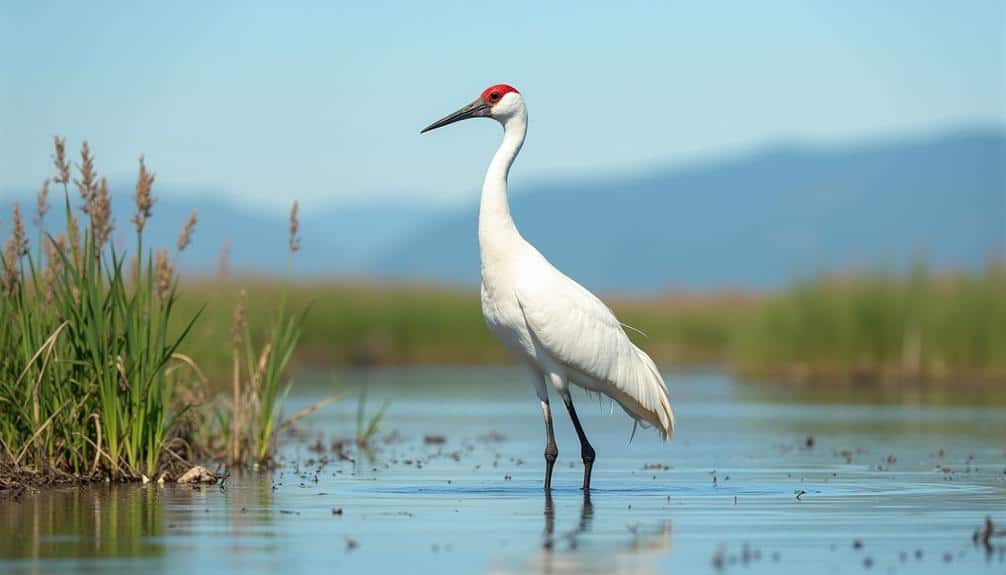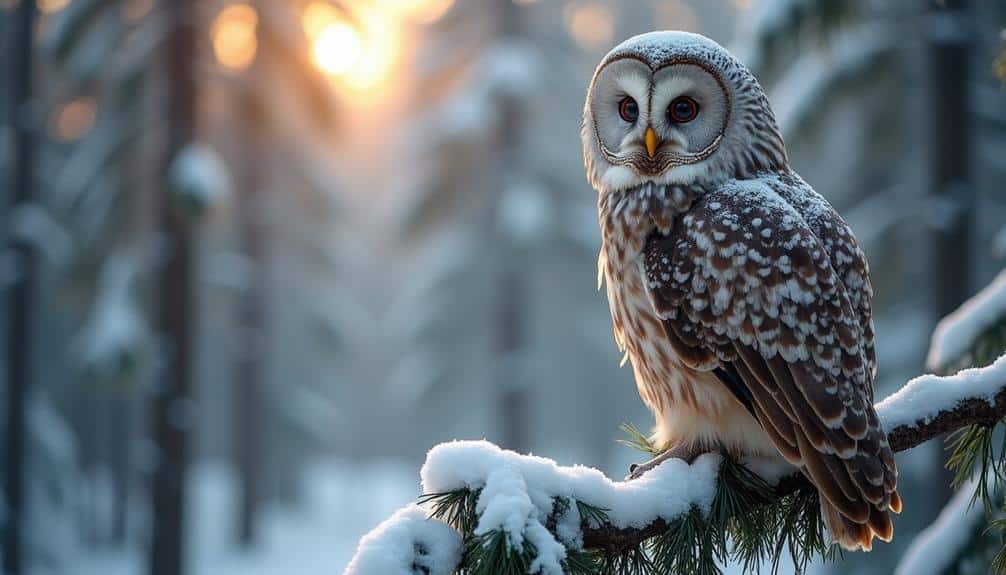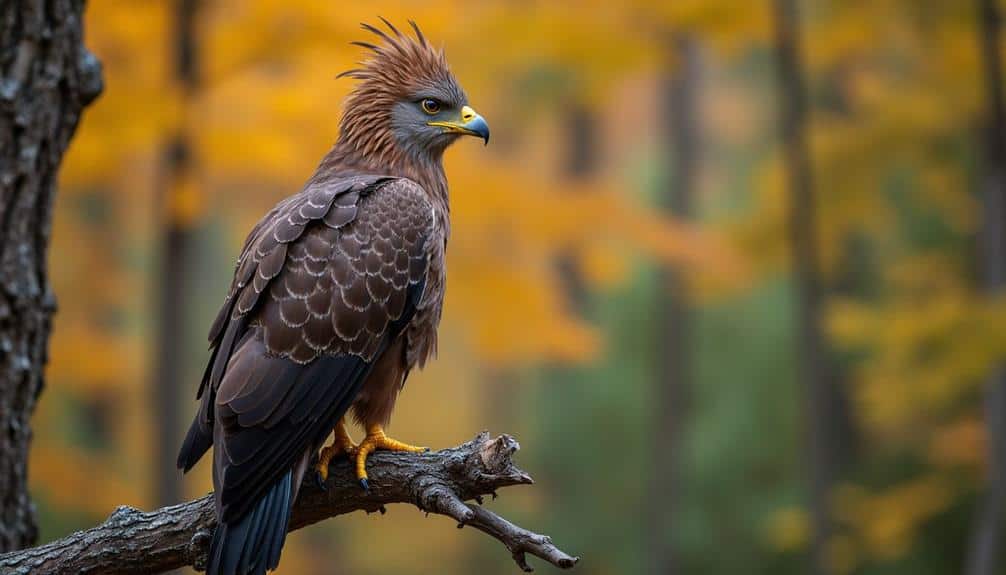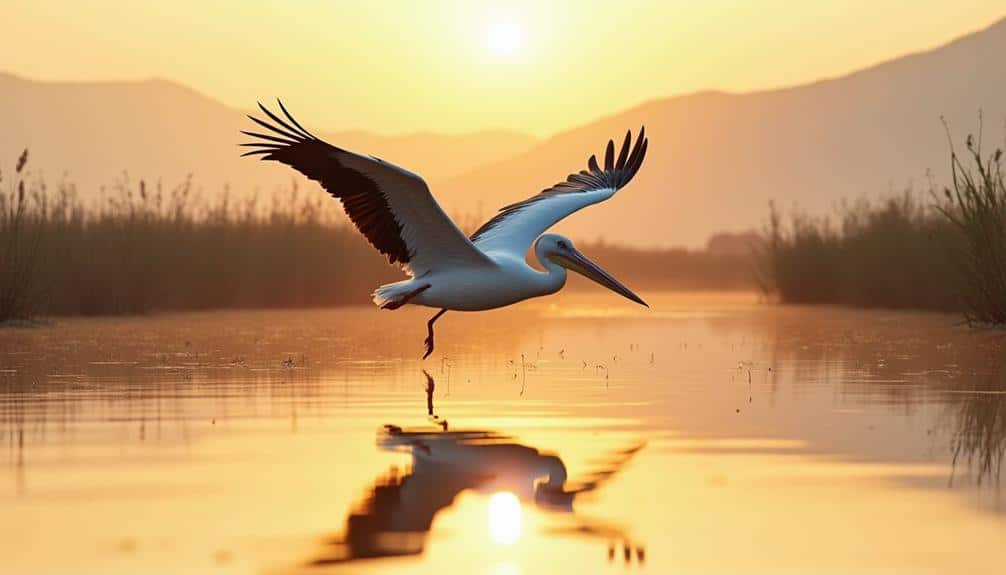Russia’s vast and varied landscapes provide a haven for some of the world’s most unique avian species. From the critically endangered Siberian Crane with its elegant white plumage to the formidable Steller’s Sea Eagle, recognized by its striking features and broad wingspan, these birds embody the rich biodiversity of the region. The Baikal Teal, known for its vibrant coloring, the majestic Eastern Imperial Eagle, and the distinctive Dalmatian Pelican also inhabit these diverse terrains. Each species, including the elusive Red-breasted Goose and the iconic Snowy Owl, presents a compelling story of survival and adaptation, inviting a closer look at their ecological significance.
Siberian Crane

The Siberian Crane, an elegant and critically endangered species, is one of the most remarkable avian inhabitants of Russia. Known scientifically as *Leucogeranus leucogeranus*, this majestic bird is distinguished by its pristine white plumage, contrasting vividly with its dark primary feathers and a striking red face. Standing at nearly 140 centimeters tall, the Siberian Crane is not only a visual spectacle but also an ecological treasure.
The species primarily breeds in the wetlands of northeastern Siberia. These regions provide the necessary resources for nesting and raising their young.
Unfortunately, the Siberian Crane faces numerous threats, including habitat loss, climate change, and illegal hunting. The degradation of their wetland habitats, particularly due to agricultural expansion and industrial activities, has considerably impacted their population.
Conservation efforts are vital for the survival of the Siberian Crane. Various international and local organizations are working tirelessly to protect their breeding and wintering grounds.
Initiatives such as habitat restoration, legal protection, and community engagement aim to guarantee a stable future for this iconic species. With concerted efforts, it is hoped that the Siberian Crane will continue to grace the skies of Russia for generations to come.
Steller’s Sea Eagle
Renowned for its striking appearance and formidable presence, Steller’s Sea Eagle (*Haliaeetus pelagicus*) stands as another extraordinary avian species gracing the diverse landscapes of Russia. With a wingspan reaching up to 2.5 meters, it is among the largest raptors in the world, commanding attention with its sheer size and distinctive plumage. The bird’s dark brown body contrasts sharply with its white shoulders, tail, and forehead, while its bright yellow beak and talons add to its imposing demeanor.
Primarily found along the coastlines and river valleys of the Russian Far East, particularly the Kamchatka Peninsula, Steller’s Sea Eagle thrives in regions abundant with its primary prey—fish, particularly salmon. During winter, some populations migrate to Japan, South Korea, and China, following food availability.
Steller’s Sea Eagle is also notable for its conservation status. Classified as vulnerable by the International Union for Conservation of Nature (IUCN), it faces threats from habitat destruction, pollution, and climate change.
Efforts are underway to monitor and protect this majestic bird, emphasizing its importance within the ecosystem and its symbolic value to the natural heritage of Russia.
Baikal Teal
While the Black-capped Marmot endures the rugged terrains of Siberia, another remarkable species, the Baikal Teal (*Sibirionetta formosa*), graces the wetlands and freshwater lakes of Russia. Known for its striking plumage, the Baikal Teal exhibits a distinctive combination of colors: males display a vibrant mix of green, yellow, and black on their heads, while their bodies are adorned with intricate patterns of brown, gray, and white.
Females, though more subdued in coloration, are equally remarkable with their mottled brown feathers, providing effective camouflage in their natural habitat.
Primarily inhabiting the regions surrounding Lake Baikal, the world’s deepest freshwater lake, these ducks undertake seasonal migrations to the wetlands of Southeast Asia during winter. The Baikal Teal prefers shallow waters rich in vegetation, which support its diet of aquatic plants, invertebrates, and small fish.
Their feeding behavior is both dabbling and diving, allowing them to exploit various food sources efficiently.
Conservation efforts are vital for this species, as habitat loss and degradation pose significant threats. International cooperation and habitat protection are essential to guarantee the continued survival of the Baikal Teal, a true marvel of Russia’s avian biodiversity.
Ural Owl

The Ural Owl (*Strix uralensis*), a formidable predator of the Russian forests, commands attention with its imposing presence and haunting call. This medium-sized owl, measuring approximately 50-59 cm in length with a wingspan reaching up to 125 cm, exhibits a striking appearance characterized by its round head, facial disk, and absence of ear tufts. Its plumage is mainly pale grey with brown streaks, providing effective camouflage against the backdrop of dense woodlands.
Primarily inhabiting the taiga and mixed forests of Russia, the Ural Owl is also found in parts of Scandinavia and Eastern Europe. It prefers mature forests with a rich understory, offering ample hunting grounds.
The owl’s diet is diverse, comprising small mammals such as voles and mice, as well as birds and insects. It employs a sit-and-wait hunting strategy, utilizing its acute hearing and vision to detect prey.
Reproduction involves nesting in tree cavities or old nests of other birds, where the female typically lays 2-4 eggs. Both parents actively participate in rearing the young, showcasing a strong commitment to offspring survival.
The Ural Owl plays an essential role in its ecosystem, controlling small mammal populations and maintaining ecological balance.
Snowy Owl
Emerging from the stark, icy landscapes of the Russian tundra, the Snowy Owl (*Bubo scandiacus*) captivates with its majestic presence and pristine white plumage. This remarkable bird, well-adapted to its harsh environment, is a symbol of the Arctic wilderness.
With a wingspan reaching up to 1.5 meters, the Snowy Owl is among the largest owls, and its powerful flight enables it to traverse vast expanses in search of prey.
Primarily a ground-nester, the Snowy Owl prefers open tundra and coastal areas where it can easily spot lemmings, its primary food source. During winter, it may venture southward, occasionally reaching temperate regions.
Its feathers are specially adapted for insulation against freezing temperatures, and its acute vision and hearing are critical for hunting in low-light conditions.
Notably, the Snowy Owl exhibits sexual dimorphism. Males are generally whiter, aiding in camouflage against the snow, while females and juveniles display darker barring.
This coloration provides essential concealment from predators and for hunting tactics. The Snowy Owl’s presence in the Russian tundra underscores the intricate balance of the Arctic ecosystem and the remarkable adaptations required for survival in one of Earth’s most extreme environments.
Crested Honey Buzzard

Among the diverse avian species inhabiting Russia, the Crested Honey Buzzard (*Pernis ptilorhynchus*) stands out for its unique dietary preferences and striking appearance. This bird of prey is distinct in its primary diet, which includes wasp larvae and honeycombs. To access these, the Crested Honey Buzzard employs specialized adaptations such as a waxy coating on its feathers to protect against stings and a robust beak to break into nests.
The Crested Honey Buzzard is visually remarkable, featuring a crest of feathers on its head that can be raised or lowered. Its plumage varies, with a mix of brown, white, and rufous tones, aiding in camouflage within forested environments.
These birds are primarily found in the mixed and deciduous forests of the Russian Far East, particularly in regions like Primorsky Krai.
Notably, the Crested Honey Buzzard exhibits a migratory pattern, traveling to Southeast Asia during the winter months. This migration is essential for survival, as it guarantees access to food resources year-round.
Understanding the Crested Honey Buzzard’s ecological role and behavioral adaptations provides valuable insights into the biodiversity and complexity of Russia’s avian fauna.
Eastern Imperial Eagle
Shifting focus from the Crested Honey Buzzard, another remarkable raptor that graces the Russian skies is the Eastern Imperial Eagle (*Aquila heliaca*). This majestic bird of prey is known for its striking appearance and impressive wingspan, which can reach up to 2.1 meters.
Characterized by its dark brown plumage with contrasting pale head and neck feathers, the Eastern Imperial Eagle is a sight to behold in its natural habitat.
Primarily found in the steppes and forested regions of Russia, this species prefers open landscapes that facilitate hunting. Their diet mainly consists of small mammals such as hares and ground squirrels, although they are also known to prey on birds and reptiles. The Eastern Imperial Eagle’s keen eyesight and powerful talons make it a formidable hunter.
Unfortunately, the population of the Eastern Imperial Eagle has been declining, primarily due to habitat destruction, illegal hunting, and poisoning from pesticides.
Conservation efforts are essential to protect this vulnerable species. In Russia, several initiatives aim to preserve their natural habitats and mitigate human-induced threats.
The Eastern Imperial Eagle serves as both an emblem of Russia’s rich biodiversity and a reminder of the need for continued conservation efforts.
Dalmatian Pelican

An impressive addition to Russia’s avian diversity, the Dalmatian Pelican (*Pelecanus crispus*) is renowned for its massive size and distinctive appearance. As one of the largest pelican species, it boasts a wingspan that can reach up to 3.5 meters, making it an awe-inspiring sight in its natural habitat. This grand bird is characterized by its curly nape feathers, vivid orange-red pouch during the breeding season, and silvery-white plumage.
The Dalmatian Pelican inhabits large, shallow wetlands, including lakes, rivers, and estuaries, primarily in southern Russia. These areas provide the fish-rich waters essential for its diet, which mainly consists of carp, perch, and other freshwater species.
Adaptable and resilient, the pelican is also known for its migratory patterns, traveling across vast distances to find suitable breeding and feeding grounds.
Conservation efforts are critical for the Dalmatian Pelican, as its population is vulnerable due to habitat loss, pollution, and human disturbance. Protective measures, such as the establishment of nature reserves and international cooperation, aim to stabilize and increase its numbers.
The presence of the Dalmatian Pelican in Russia underscores the country’s role in safeguarding global biodiversity and highlights the importance of preserving natural ecosystems.
Red-breasted Goose
The Red-breasted Goose (*Branta ruficollis*), a striking and colorful bird, captivates ornithologists and birdwatchers alike with its vibrant plumage and distinctive markings. Found mainly in Arctic Siberia, this species migrates to warmer climates, including the Black Sea coasts, during the harsh winter months.
Characterized by its vivid red, white, and black feathers, the Red-breasted Goose is instantly recognizable. Its chestnut-red breast contrasts sharply with the black and white patterns on its face and flanks, making it one of the most visually appealing geese. Typically, these birds measure around 53-56 cm in length and have a wingspan of 116-135 cm, making them relatively small compared to other geese species.
Their preferred habitats include tundra regions during breeding season and wetlands or agricultural fields during migration. The Red-breasted Goose’s diet consists mainly of grasses, leaves, and seeds, though it occasionally consumes small invertebrates.
Conservation status is currently classified as Vulnerable due to habitat loss, hunting, and climate change impacts. Efforts to protect this unique species are ongoing, involving international collaboration to preserve its critical habitats and migration routes.




